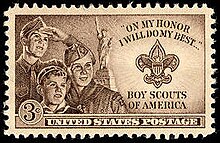Boy Scouts of America

The Boy Scouts of America or BSA is an organization for children and teens with over 5 million members across the United States. They try to give young people life values.[1] BSA includes Cub Scouts, which is for children ages 6–11, Scouts BSA, which is for youth ages 11–17, and Venturing, Sea Scouts, and Exploring for youth ages 14–20. Scouts BSA was called Boy Scouts until it started allowing girls in 2018.[2]
Organization[change | change source]
Scouts BSA are ages 11–17 and belong to troops, groups of Scouts associated with a church, school or post. Cub Scouts are scouts ages 6–11 and belong to packs. Cub Scouts include Tigers (age 6-7), Wolfs (age 7-8), Bears (age 8-9), and Webelos (age 9-11). Older Scouts can be Venturer Scouts.
History[change | change source]
The Boy Scouts of America were founded by American writer W. D. Boyce, in 1910, but were similar to Scouting groups in Great Britain and other early scout movements.[3] James E. West helped out the BSA in its early years, but also made the BSA more religious than scouts were in Europe. Scouting grew in the 1910s and 20s due to the rise of “boy’s books” devoted to Scouting and the First World War. Scouting had many members during the 1960s, but has declined since the 1970s, despite an attempt to make scouting modern by changing requirements and adding more merit badges.
Controversies[change | change source]
Over the years, the BSA has taken some stands that many Americans did not like. These included being against unions (organized workers) in the 1920s, requiring Scouts to believe in God, and not allowing gays to join Scouting.
Rank[change | change source]
An important part of scouting is earning ranks. There are seven ranks in Scouts BSA: Scout, Tenderfoot, 2nd Class, 1st Class, Star, Life and Eagle. The first four focus on learning basic scout skills, including camping, cooking, swimming, first aid (basic medical care), citizenship, orienteering (use of a map and compass), and pioneering (tying knots). The final three focus on earning merit badges, serving the troop and serving the community. Eagle Scouts must plan and finish a project that benefits something other than Scouting, and earn 21 merit badges. They must also hold a position of leadership in the troop. Only about 2 or 3% of Scouts earn Eagle, but some of the ones that have include Gerald Ford and Neil Armstrong.[4]
Oath and law[change | change source]
Scouts must learn, know and follow the Scout Oath and Scout Law:[5]
Scout Oath[change | change source]
These are the words of the Scout Oath:
- "On my honor I will do my best, to do my duty to God and my country and to obey the Scout Law; to help other people at all times; to keep myself physically strong, mentally awake, and morally straight".
Scout Law[change | change source]
A scout is:
- trustworthy,
- loyal,
- helpful,
- friendly,
- courteous,
- kind,
- obedient,
- cheerful,
- thrifty,
- brave,
- clean, and
- reverent.
Related pages[change | change source]
References[change | change source]
- ↑ "BSA Vision Statement". U.S. Scouting Service Project. http://www.usscouts.org/usscouts/aboutbsa/vision.asp. Retrieved on 2008-07-22.
- ↑ "Girls can now join Scouts BSA, once known as Boy Scouts". www.cbsnews.com. Retrieved 2020-08-05.
- ↑ Petterchak, Janice A. (2003). Lone Scout: W. D. Boyce and American Boy Scouting. Rochester, Illinois: Legacy Press. pp. 63–67. ISBN 0-9653198-7-3.
- ↑ "All BSA Eagle Scout Requirements since 1911". www.troop97.net.
- ↑ "Mission Statement and Vision Statement". Scouting.org. Boy Scouts of America. 2011. Retrieved 13 July 2017.[permanent dead link]
